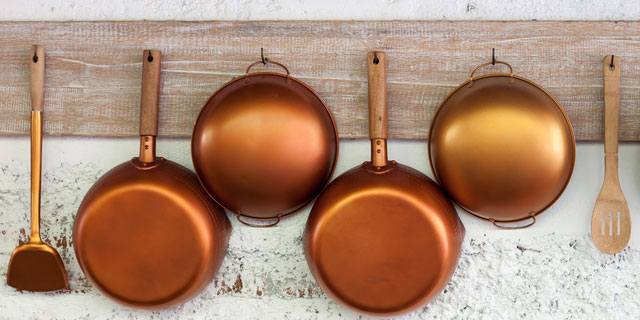A ruined pot can destroy food just as easily as adding too much salt to a dish. But treat your pots and pans right and they can give you a lifetime of delicious meals. How do you know when it’s time to give up on those cooper pots your grandmother gave you or to upgrade from your sister’s hand-me downs? Well, Googling is always good, except you might end up learning about how long marijuana stays fresh. TLK spoke with David Malek of Gunter Wilhelm and Chef Matthew Burton of Carlisle Foodservice Products to learn how to maintain and store kitchen pots and pans — and when to chuck them.
When to Replace
Just because a pot looks gross doesn’t mean it needs to go in the trash. Sometimes, all a pot needs is a good cleaning. However, there are a few signs that mean it is time to toss your pots and pans.
Burton looks for three things to determine if it’s time to replace a pot:
- On nonstick pots, check for scratches that allow you to see metal under the coating. If you can see the metal it’s time to toss.
- On other types of pots, if it doesn’t sit flat on a table it means the bottom has rounded, which can cause hot spots and allow sauces to burn. Time to toss.
- And finally, if the handle or rivets are weak or loose, it’s dangerous to use the pot. Time to toss.
Next, how to maintain your pots… [pagebreak]
How to Maintain Your Pots
Once you have a decent set of pots and pans, proper cleaning and storage can make them last a lifetime.
“In general if you take care of pans and follow the cleaning instructions that come with them most pans do not have a life expectancy,” Burton said. “I have a cast iron pan that is over 100 years old that I still use. And a non stick pan that is 30 plus years that I still use, because I know how to take care of them and to more importantly store them.”
Always, always, always read the care instructions that come with your pots and pans and clean and store them as directed. Here are some pointers.
- Nonstick Pans: Hand wash with a nonabrasive cleaner and sponge. For harder spots, clean with 1/2 cup of white vinegar and water.
- Stainless Steel Pans: Clean with warm vinegar and do not stack.
- Cooper Pans: Often lined with tin or stainless steel, these linings may need to be replaced every so often otherwise use salt and lemon or white vinegar to clean.
- Cast Iron Pans: Clean the surface like you wood a grill and avoid cooking with water (that could lead to rust). A salt scrub can get rid of stuck on food and vinegar may remove some rust.
Next, more tips and tricks for pots and pans… [pagebreak]
General Tips and Tricks
“Each type of pan has its own cleaning needs, but regardless of the pan, a few general rules always apply,” Burton said.
There are eight rules Burton and Whilem said everyone should follow that will increase the lifespan of your pots and pans:
- Never put a hot pan right in to cold water…it will warp and destroy the pan.
- Always use a soft, non-abrasive cleaning agent and scrubber.
- All pans should be dried…do not put away wet pans where water can pool in the bottom and cause rust or bacteria growth.
- The best way to store pans is to hang them, if possible. If not, they can be stacked upside down on shelves no more than three high; if non-stick, the pans should be separated with a clean towel to keep from scratching.
- Be careful over high heat so you don’t burn the pot.
- Only use soft utensils such as wood spoons and silicon spatulas in the pan.
- Use pans for what they are meant for. Sometimes people use pans as meat tenderizers, or to store sauces; this will wear away the pans metal and reduce usage.
- Always clean. Pans have to be cleaned as soon as possible and food can not be left to sit in them. If food gets burned, soak the pots and scrub them carefully; pans with burn spots and food bits left on them are not only unsanitary, the acids and bacteria in the foods slowly destroy the pans.


![Making Mealtime Matter with La Familia: Easy Sofrito [Video]](https://thelatinkitchen.com/wp-content/uploads/2015/10/sofrito-shutterstock__0-500x383.jpg)
![Easy Latin Smoothies: Goji Berry Smoothie [Video]](https://thelatinkitchen.com/wp-content/uploads/2015/12/goji_berry-shutterstock_-500x383.jpg)
















![Fun and Fast Recipes: Fiesta Cabbage Salad [Video]](https://thelatinkitchen.com/wp-content/uploads/2015/11/fiesta_cabbage_slaw-shutterstock_-500x383.jpg)









